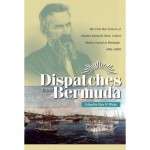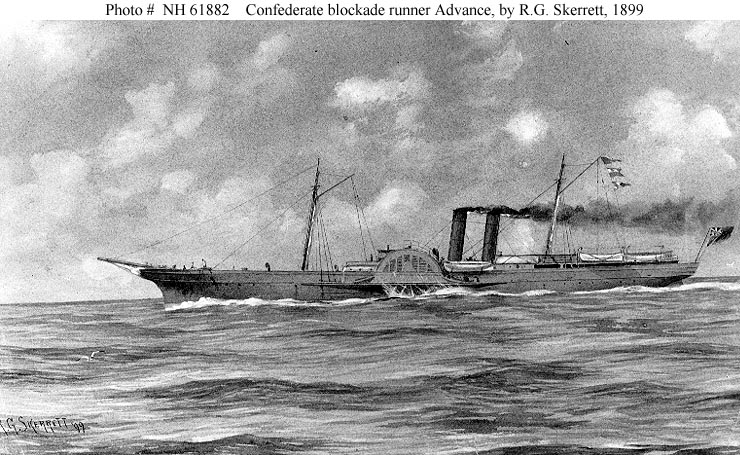History: Bermuda and the Blockade Runners
April, 2011 will mark the 150th anniversary of the Confederate bombardment of the Federal Army’s Fort Sumter in Charleston, South Carolina — initiating the devastating American Civil War (1861-65) and turning Bermuda into a mid-Atlantic front in the bloodiest conflict in US history.
The island can likely anticipate some cultural tourism starting next year as Americans hold somber, nationwide observations to mark the outbreak of the Civil War — during which an estimated 600,000 people were killed. more than combined US casualties in World War One, World War Two, Korea and Vietnam.
Beginning in December, 1860, a total of 11 Southern states started to secede from the Union. Among other things, the slave-holding states disagreed with the anti-slavery views of the Union.
During the war, Union forces used their navy to create a blockade of Southern ports — hoping to break the South’s economy, deprive its troops of materiel and munitions and force the newly-created Confederate States of America to surrender. Known as the Anaconda Plan, this blockade stretched from Maryland down the Eastern seaboard, around Florida, and into the Gulf of Mexico.
As a consequence of the naval blockade, Bermuda — along with the Bahamas and Cuba — became a centre of Confederate commerce. A steady stream of fast-running ships from the South clandestinely skirted the Union blockade, passing through St. George’s carrying cotton from Charleston, South Carolina and Wilmington, North Carolina for English manufacturers; they made the return journeys freighted with European armaments. Bermuda was both a transhipment point where cotton was directly exchanged for British weapons warehoused here and a refuelling depot for Confederate blockade runners making transatlantic runs.
A recently published book, “Dispatches From Bermuda: The Civil War Letters of Charles Maxwell Allen, United States Consul at Bermuda, 1861-1888″, chronicles the sometimes exasperating — and occasionally dangerous — mission of the Union’s diplomatic representative in Bermuda to maintain a vigil on illicit Confederate trade.
 Appointed to the Bermuda post by President Abraham Lincoln in 1861, Charles Maxwell Allen courted open hostility when he arrived on the island. St. George’s was booming as a result of funneling contraband to the South — as Maxwell recorded, a single blockade runner which sank after only three voyages generated a profit of more than £173,000. British military and diplomatic officials here, officially neutral during the War Between the States, turned wilfully blind eyes to blockade-running activities which enriched both Bermudians and English industrialists.
Appointed to the Bermuda post by President Abraham Lincoln in 1861, Charles Maxwell Allen courted open hostility when he arrived on the island. St. George’s was booming as a result of funneling contraband to the South — as Maxwell recorded, a single blockade runner which sank after only three voyages generated a profit of more than £173,000. British military and diplomatic officials here, officially neutral during the War Between the States, turned wilfully blind eyes to blockade-running activities which enriched both Bermudians and English industrialists.
“Especially in the first years of the war, before the tide began to turn at Gettysburg, Bermuda was an extremely hostile posting,” said one reviewer. “Not only were many openly sympathetic to the rebel cause, but Bermuda itself was known as the ‘offshore Confederacy’, her ports filled with vessels flying the (Confederate) Stars and Bars, and her streets swarming with Southerners engaged in the some aspect of blockade running. In April 1862 Allen wrote, in a letter to his family, ‘There are a great many Southern people here; 14 came in the steamer ‘Bermuda’. They & their friends are down on me & have threatened to whip me’. Allen’s first years there were lonely; he was shunned, reviled, and the flagpole at the consulate was cut down.”
Some blockade runners were hunted down by Union warships as they attempted to either enter or leave St. George’s. Others came to grief on Bermuda’s reefs, including the “Nola”, a 236-foot paddle steamer which also sailed under the names “Montana” and “Paramount”. On December 30, 1863, enroute from London to North Carolina, while carrying a cargo for the Confederacy and after completing the first leg of her maiden voyage across the Atlantic, the “Nola” attempted to enter Bermuda to take on coal. She was wrecked near Western Blue Cut on Bermuda’s reefs. A steam boat was dispatched from St. George’s to assist her and saved the crew and much of the cargo. But the stricken verssel could not be pulled from the reef due to a ten foot hole in her side. Lying in less than 40 feet of water, the wreck remains a favourite site for archeologists and recreational divers.
 Bermuda’s role as a hub of blockade-running is commemorated at the Bermuda National Trust’s Tucker House Museum. During the Civil War, the historic St. George’s building was the headquarters of Confederate agents operating in Bermuda. A permanent exhibition at the museum called “Rogues and Runners: Bermuda and the American Civil War” highlights the island’s role in maintaining what’s been called the South’s life-line during the Civil War. A comprehensive and lavishly-illustrated 2003 book based on the exhibit is also available.
Bermuda’s role as a hub of blockade-running is commemorated at the Bermuda National Trust’s Tucker House Museum. During the Civil War, the historic St. George’s building was the headquarters of Confederate agents operating in Bermuda. A permanent exhibition at the museum called “Rogues and Runners: Bermuda and the American Civil War” highlights the island’s role in maintaining what’s been called the South’s life-line during the Civil War. A comprehensive and lavishly-illustrated 2003 book based on the exhibit is also available.
“In the chapter ‘Sitting on a Powder Keg’, the author recounts the precarious neutrality of Bermuda,” commented one reviewer. “Belligerents on both sides cared little for the law, seeking to use the islands as bases for military operations. Despite the complaints of the British island government, a US squadron led by the troublesome Commodore Charles Wilkes blockaded the entrance to St. George’s, Bermuda, for more than a week, boarding and examining every ship entering or leaving the harbor. More often, US ships hovered offshore, waiting to snatch up blockade runners emerging from port, a marginally legal tactic. Southerners, in turn, launched attacks from Bermuda on US ships, such as the Confederate naval guerillas who burned the Union mail-steamer ‘Roanoke’ in sight of shore in October 1864. The British colonial government monitored both sides to try to maintain strict neutrality, but only the latent threat of the powerful Royal Navy fleet based at Bermuda kept the belligerents from open warfare within British boundaries.
“…Bermuda has a long history as a maritime crossroads, where shipping routes between Europe and the Americas connected. Proximity to America helped promote steady trade between Bermuda and the other British American colonies and encouraged early interchanges of ideas, trade, and technology. At times, this proximity to shipping routes has landed the island of Bermuda a defining role in world events many times greater than its small size. The American Civil War was one of those events. This book tells that story well.”
Read More About
Comments (3)
Trackback URL | Comments RSS Feed
Articles that link to this one:
- Bermuda’s Role In “Gone With The Wind” | Bernews.com | March 3, 2013
- Bermuda On Show At 1924 London Exhibition | Bernews.com | March 29, 2013



Great Article!